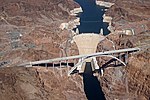Lake Mead National Recreation Area

Lake Mead National Recreation Area is a U.S. national recreation area in southeastern Nevada and northwestern Arizona. Operated by the National Park Service, Lake Mead NRA follows the Colorado River corridor from the westernmost boundary of Grand Canyon National Park to just north of the cities of Laughlin, Nevada and Bullhead City, Arizona. It includes all of the eponymous Lake Mead as well as the smaller Lake Mohave – reservoirs on the river created by Hoover Dam and Davis Dam, respectively – and the surrounding desert terrain and wilderness.Formation of Lake Mead began in 1935, less than a year before Hoover Dam was completed. The area surrounding Lake Mead was protected a bird refuge in 1933, later established as the Boulder Dam Recreation Area in 1936 and the name was changed to Lake Mead National Recreation Area in 1947. In 1964, the area was expanded to include Lake Mohave and its surrounding area and became the first National Recreation Area to be designated as such by the U.S. Congress.
Excerpt from the Wikipedia article Lake Mead National Recreation Area (License: CC BY-SA 3.0, Authors, Images).Lake Mead National Recreation Area
Lakeshore Road,
Geographical coordinates (GPS) Address Nearby Places Show on map
Geographical coordinates (GPS)
| Latitude | Longitude |
|---|---|
| N 36.009722222222 ° | E -114.79666666667 ° |
Address
Lake Mead Visitor Center
Lakeshore Road
Nevada, United States
Open on Google Maps







